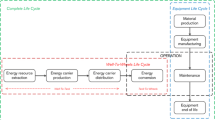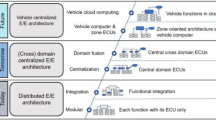Abstract
In this study, the design methodology for PHEV component design environment is proposed, which consists of power evaluation, component evaluation, component analysis and vehicle performance evaluation environments. First, PHEV simulators were developed based on the dynamic model of the target PHEV powertrain, and a PHEV control algorithm was designed based on the general power-split type PHEV using MATLAB/Simulink. Experimental results were used to validate the constructed PHEV simulators. The power evaluation environment provides the magnitude and direction of the power between components at the vehicle level at any selected time that the user wants to evaluate. The component evaluation environment is designed to evaluate the parameter behaviors of a component using the effort-flow causality relationship. The component analysis environment is designed to investigate component performance according to the variations of component parameters. The vehicle evaluation environment is designed to evaluate equivalent fuel economy at any selected time. It is expected that the design methodology of the PHEV component design environment proposed in this study can be extended to other x-EVs for evaluating and designing vehicle components.
Similar content being viewed by others
References
Abdul Rahman, S., Zhang, N. and Zhu, J. (2008). Modeling and simulation of an energy management system for plug-in hybrid electric vehicles. Australasian Universities Power Engineering Conf. (AUPEC’08).
Argonne National Laboratory (2012). Modeling, Simulation & Software-PSAT. http://www.transportation.anl.gov/modeling_simulation/PSAT/
AVL (2012). AVL Cruise. https://www.avl.com/cruise1/
Falieres, Q., Grasset, O., Roblet, K., Xu, Y., Noiret, C., Serrao, L. and Sciarretta, A. (2011). A contradictory analysis of GM voltec powertrain. EEVC, Bruusels, Belgium.
Gopal, R. and Rousseau, A. (2011). System analysis using multiple expert tools. SAE Paper No. 2011-01-0754.
Halbach, S., Sharer, P., Pagerit, S., Rousseau, A. and Folkerts, C. (2010). Model architecture, methods, and interfaces for efficient math-based design and simulation of automotive control systems. SAE Paper No. 2010-01-0241.
Johnson, V., Wipke, K. and Rausen, D. (2000). HEV Control Strategy for Real-Time Optimization of Fuel Economy and Emissions. SAE.
Karbowski, D., Pagerit, S., Kwon, J., Rousseau, A. and Pechmann, K. (2009). Argonne National Laboratroy, Fair comparison of powertrain configurations for plug-in hybrid operation using global optimization. SAE Paper No. 2009-01-1334.
Karnopp, D., Margolis, D. and Rosenberg, R. (2005). Modeling and Simulation of Mechatronic Systems. John Wiley & Sons. Hoboken. New Jersey.
LMS (2012). LMS Imagine, Lab AMESim. http://www.lmsintl.com/LMS-Imagine-Lab-AMESim
Ma, C. (2010). Development of Hybrid Electric Vehicle Simulator for Sub-module Design. M.S. Thesis. Sungkyunkwan University. Korea.
Ma, C., Kang, J., Choi, W., Song, M., Ji, J. and Kim, H. (2012). Comparative study on power characteristics and control strategies for plug-in hybrid electric vehicle. Int. J. Automotive Technology 12,3, 505–516.
Mapelli, F., Mauri, M. and Tarsitano, D. (2009). Energy control strategies comparison for a city car plug-in HEV. IECON 35th Annual Conf. IEEE, 3729–3734.
Mathworks (2012). Mechanical Systems Simulation-SimDriveline. http://www.mathworks.co.kr/products/simdrive/
Miller, M., Holmes, A., Conlon, B. and Savagian, P. (2011). General Motors Company, The GM ‘Voltec’ 4ET50 multi-mode electric transaxle. SAE Paper No. 2011-01-0887.
Rosenberg, R. R. and Karnopp, D. C. (1983). Introduction to Physical System Dynamics. McGraw-Hill. New York.
Shidore, N., Bohn, T., Lohse-Busch, H. and Sharer, P. (2007). PHEV ‘All electric range’ and fuel economy in charge sustaining mode for low SOC operation of the JCS VL41M Li-ion battery using battery HIL. Proc. Electric Vehicle Symp., 23, Anaheim, CA.
Situ, L. (2009). Electric vehicle development: The past, present & future. 3rd Int. Conf. Power Electronics Systems and Applications, K210509135.
Song, M., Ko, S., Kim, J., Lee, J., Kim, Y., Kim, J. and Kim, H. (2010). Control algorithm of the electric oil pump for the automatic-transmission-based hybrid electric vehicle. EVS-25.
Srinivasan, P. and Kothalikar, U. M. (2009). Performance fuel economy and CO2 prediction of a vehicle using AVL Cruise simulation techniques. SAE Paper No. 2009-01-1862.
Sun, L., Liang, R. and Wang, Q. (2008). The control strategy and system preferences of plug-in HEV. IEEE Vehicle Power and Power and Propulsion Conf. (VPPC).
Author information
Authors and Affiliations
Corresponding author
Rights and permissions
About this article
Cite this article
Ma, C., Ko, S.Y., Jeong, K.Y. et al. Design methodology of component design environment for PHEV. Int.J Automot. Technol. 14, 785–795 (2013). https://doi.org/10.1007/s12239-013-0087-y
Received:
Revised:
Accepted:
Published:
Issue Date:
DOI: https://doi.org/10.1007/s12239-013-0087-y




